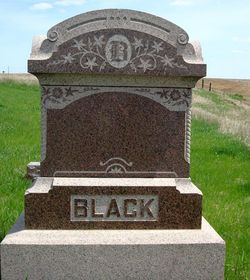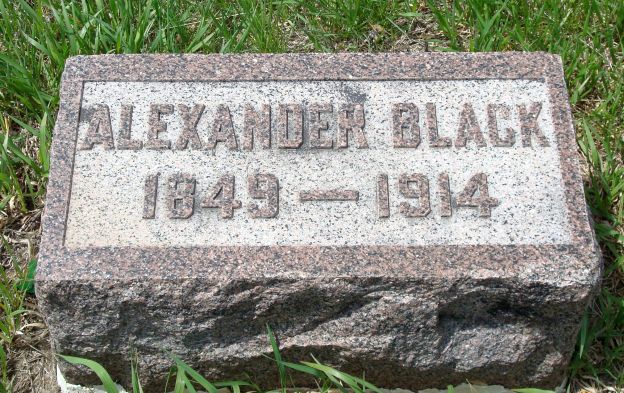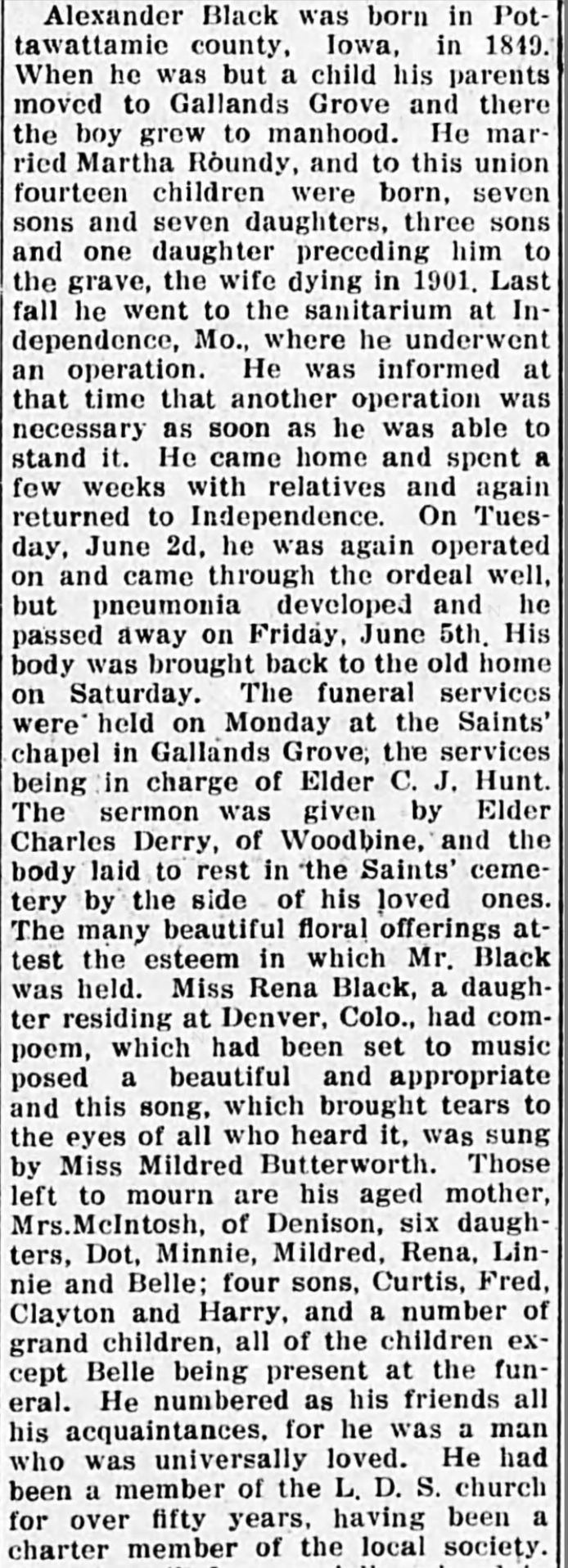ALEXANDER BLACK
ALEXANDER BLACK was born in Pottawattamie County, Iowa, September 29, 1849, and is the son of Curtice and Malinda (Hunt) Black, natives of Mississippi and Kentucky respectively. They came to Iowa in the year 1848, and in 1856 came to Shelby County; here our subject was reared to farm life and educated in the common schools. At the age of twenty-three years Mr. Black was united in marriage to Martha J., daughter of Uriah and Rena Roundy; she was born in Pottawattamie County, Iowa, September 6, 1850; the date of their wedding is August 18, 1873. They are the parents of ten children -- Frederick, Effie, Mary Ann, Harry, Merrill, Rena, Mildred, Malinda J., Curtice Uriah and Bertha B. After their marriage Mr. and Mrs. Black settled on an eighty-acre tract of land in Grove Township, which was partially improved; here they have since made their home, erecting good frame buildings for stock and grain. Mr. Black has planted an orchard of 700 trees, which is one of the finest and largest in the county. He devotes himself exclusively to agriculture and live-stock raising, giving especial attention to the better grades of horses and hogs. Mr. Black is one of the most enterprising farmers in the northern part of the county, and well deserves the esteem and respect in which he is held. He has improved 190 acres of land in the most approved way, and has served his county otherwise than in his own personal interest; he has held the office of supervisor, and a membership on the school board. He affiliates with the Democratic party, and takes an active interest in forwarding the principles of that body. Mr. and Mrs. Black are consistent members of the Latter-Day Saints church, and are numbered among the most worthy and reliable citizens of Shelby County.
Transcribed by Marthann Kohl-Fuhs.
- - - - - - - - - - -
Alexander and Martha BLACK, When a boy of twelve, he became the youngest charter member of the Galland's Grove Branch. He was born September 29, 1847, in Pottawattamie County, Iowa, the son of Malinda J Black and her first husband. Alexander came to Galland's Grove with his mother and stepfather. In August 1872, Alexander married Martha J. Roundy. She was born September 6, 1850, and was baptized in her early youth. They became the parents of fourteen children, and the entire family was a blessing to the community and church. Of Alexander it was said, 'His heart, his hand, and his house were always open to those who stood in need…neighbors sought his counsel with the utmost confidence in his judgment.' He became one of the ablest fruit growers in Shelby County, with particular interest in the growing of apples and pears. As early as 1877 he had a fine orchard. Martha died March 14, 1901. Alexander died June 5, 1914, survived by ten of his children. On January 30, 1860, after a hard horseback ride in the cold, Elder E. C. Briggs came to the home of John McIntosh at Galland's Grove. He found John reading the first edition of the Saints' Herald, specifically the letter regarding polygamy written by Isaac Sheen as published October 9, 1852, in the Cincinnati Commercial. McIntosh objected strongly to this letter. He asserted that it would be used by the enemies of the church against the true position of the Reorganization, because of its implications that Joseph was responsible for that accursed doctrine. McIntosh also objected to the wording, 'New Organization,' which could convey the idea that the Reorganization was not a continuation of the original gospel of 1830. He regretted that these errors were in the first Herald, but he was glad the church now had a periodical to report the current news. During Elder Briggs' visit, McIntosh spoke of many interesting incidents in his early church experiences, and of how the gift of the Holy Spirit was with him in all his ministry for those five years. The worst persecutions, he said, always came from the sectarian churches: 'There was nothing too low for them to report against us, and they sent their reports ahead of us to prepare the people so they would not come to hear the gospel, but we always got the ears of the thinking people.' As for Briggs, it helped him greatly to hear the old veteran recall his experiences as a young man in the work of God. Briggs wrote:
"If he had been in the dark during the great trial that came to the church in 1844, he has been an honorable man all the time, as attested by his neighbors, as they say, 'If Uncle John McIntosh has done wrong it has been to himself; he had never injured anyone else.
SOURCE: Roots of the Reorganized Latter Day Saints in Southern Iowa. By Pearl Wilcox.
Black, Alexander
Alexander ("Alec") Black was born at Council Bluffs, 1847 and came to Gallands Grove at the age of 5 years with his mother. His father died while on a business trip to Illinois. He was married to Martha Roundy in 1872. They farmed and maintained a large fruit orchard and sold fruit. It was necessary for him to make frequent trips to Council Bluffs for supplies. He made the trips by ox team and it often took 10 days to 2 weeks. It is told that one time he was late in getting started on the trip. While he was gone, ar early winter blizzard came up and he was gone for 3 weeks. All the family had left to eat when he returned was cornmeal. He and his wife had a famiy of 14 children. In the early days they lived in a log house. The farm now owned by Mrs. Raymond Thompson is the "Black Homestead". The present residence was built by "Alec" on the original foundation of the first house. The original barn and corn crib are still standing and in use today. They are of particular interest as the native lumber used for siding is nailed on vertically instead of horizontally as it is today. "Alec" and his wife were devout church workers in the Gallands Grove R.L.D.S. Church, and many of the early missionaries of their church found refuge in their home. He and his wife are buried in the small country cemetery in Gallands Grove which lies adjoining the farm on which he made his home. Time and progress seems to have a way of scattering families to the four winds, and many of these 50 United States have representatives of the Black Family. At present only two granddaughters live in Dunlap. They are Mrs. Claude Cornelius and Mrs. Lida Schlensig and their families. The grandsons Claude and Fred Black live near Woodbine. There are 310 entries in the family genealogy, 284 of which are living today.
Source: Dunlap Pioneers And Progress Centennial 1867-1967
ALEXANDER BLACK
ALEXANDER BLACK was born in Pottawattamie County, Iowa, September 29, 1849, and is the son of Curtice and Malinda (Hunt) Black, natives of Mississippi and Kentucky respectively. They came to Iowa in the year 1848, and in 1856 came to Shelby County; here our subject was reared to farm life and educated in the common schools. At the age of twenty-three years Mr. Black was united in marriage to Martha J., daughter of Uriah and Rena Roundy; she was born in Pottawattamie County, Iowa, September 6, 1850; the date of their wedding is August 18, 1873. They are the parents of ten children -- Frederick, Effie, Mary Ann, Harry, Merrill, Rena, Mildred, Malinda J., Curtice Uriah and Bertha B. After their marriage Mr. and Mrs. Black settled on an eighty-acre tract of land in Grove Township, which was partially improved; here they have since made their home, erecting good frame buildings for stock and grain. Mr. Black has planted an orchard of 700 trees, which is one of the finest and largest in the county. He devotes himself exclusively to agriculture and live-stock raising, giving especial attention to the better grades of horses and hogs. Mr. Black is one of the most enterprising farmers in the northern part of the county, and well deserves the esteem and respect in which he is held. He has improved 190 acres of land in the most approved way, and has served his county otherwise than in his own personal interest; he has held the office of supervisor, and a membership on the school board. He affiliates with the Democratic party, and takes an active interest in forwarding the principles of that body. Mr. and Mrs. Black are consistent members of the Latter-Day Saints church, and are numbered among the most worthy and reliable citizens of Shelby County.
Transcribed by Marthann Kohl-Fuhs.
- - - - - - - - - - -
Alexander and Martha BLACK, When a boy of twelve, he became the youngest charter member of the Galland's Grove Branch. He was born September 29, 1847, in Pottawattamie County, Iowa, the son of Malinda J Black and her first husband. Alexander came to Galland's Grove with his mother and stepfather. In August 1872, Alexander married Martha J. Roundy. She was born September 6, 1850, and was baptized in her early youth. They became the parents of fourteen children, and the entire family was a blessing to the community and church. Of Alexander it was said, 'His heart, his hand, and his house were always open to those who stood in need…neighbors sought his counsel with the utmost confidence in his judgment.' He became one of the ablest fruit growers in Shelby County, with particular interest in the growing of apples and pears. As early as 1877 he had a fine orchard. Martha died March 14, 1901. Alexander died June 5, 1914, survived by ten of his children. On January 30, 1860, after a hard horseback ride in the cold, Elder E. C. Briggs came to the home of John McIntosh at Galland's Grove. He found John reading the first edition of the Saints' Herald, specifically the letter regarding polygamy written by Isaac Sheen as published October 9, 1852, in the Cincinnati Commercial. McIntosh objected strongly to this letter. He asserted that it would be used by the enemies of the church against the true position of the Reorganization, because of its implications that Joseph was responsible for that accursed doctrine. McIntosh also objected to the wording, 'New Organization,' which could convey the idea that the Reorganization was not a continuation of the original gospel of 1830. He regretted that these errors were in the first Herald, but he was glad the church now had a periodical to report the current news. During Elder Briggs' visit, McIntosh spoke of many interesting incidents in his early church experiences, and of how the gift of the Holy Spirit was with him in all his ministry for those five years. The worst persecutions, he said, always came from the sectarian churches: 'There was nothing too low for them to report against us, and they sent their reports ahead of us to prepare the people so they would not come to hear the gospel, but we always got the ears of the thinking people.' As for Briggs, it helped him greatly to hear the old veteran recall his experiences as a young man in the work of God. Briggs wrote:
"If he had been in the dark during the great trial that came to the church in 1844, he has been an honorable man all the time, as attested by his neighbors, as they say, 'If Uncle John McIntosh has done wrong it has been to himself; he had never injured anyone else.
SOURCE: Roots of the Reorganized Latter Day Saints in Southern Iowa. By Pearl Wilcox.
Black, Alexander
Alexander ("Alec") Black was born at Council Bluffs, 1847 and came to Gallands Grove at the age of 5 years with his mother. His father died while on a business trip to Illinois. He was married to Martha Roundy in 1872. They farmed and maintained a large fruit orchard and sold fruit. It was necessary for him to make frequent trips to Council Bluffs for supplies. He made the trips by ox team and it often took 10 days to 2 weeks. It is told that one time he was late in getting started on the trip. While he was gone, ar early winter blizzard came up and he was gone for 3 weeks. All the family had left to eat when he returned was cornmeal. He and his wife had a famiy of 14 children. In the early days they lived in a log house. The farm now owned by Mrs. Raymond Thompson is the "Black Homestead". The present residence was built by "Alec" on the original foundation of the first house. The original barn and corn crib are still standing and in use today. They are of particular interest as the native lumber used for siding is nailed on vertically instead of horizontally as it is today. "Alec" and his wife were devout church workers in the Gallands Grove R.L.D.S. Church, and many of the early missionaries of their church found refuge in their home. He and his wife are buried in the small country cemetery in Gallands Grove which lies adjoining the farm on which he made his home. Time and progress seems to have a way of scattering families to the four winds, and many of these 50 United States have representatives of the Black Family. At present only two granddaughters live in Dunlap. They are Mrs. Claude Cornelius and Mrs. Lida Schlensig and their families. The grandsons Claude and Fred Black live near Woodbine. There are 310 entries in the family genealogy, 284 of which are living today.
Source: Dunlap Pioneers And Progress Centennial 1867-1967
Family Members
-
![]()
Frederick C "Fred" Black
1873–1949
-
![]()
Effie Black Spurgeon
1874–1914
-
![]()
Mary Ann Black Keairnes
1875–1955
-
Horace Black
1878–1878
-
![]()
Harry Black
1878–1942
-
![]()
Myrl Black Pokett
1879–1921
-
![]()
Rena Black Donald
1881–1945
-
![]()
Mildred Louise Black Reed
1883–1917
-
![]()
Malinda Jane Black Baber
1886–1933
-
![]()
Curtis Uriah Black
1887–1973
-
![]()
Bertha Belle Black Morgan
1888–1943
-
![]()
Grover Cleveland Black
1890–1891
-
![]()
Glen Clayton Black
1891–1968
-
![]()
Elvin Burr Black
1892–1892
Sponsored by Ancestry
Advertisement
Advertisement























